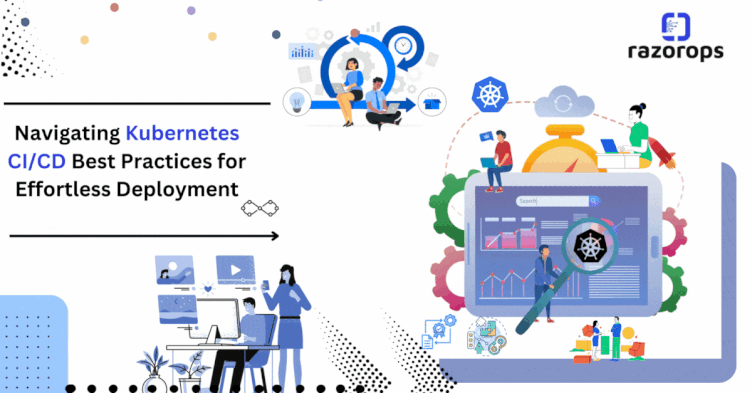
Navigating Kubernetes CI/CD Best Practices for Effortless Deployment
Navigating Kubernetes CI/CD: A Journey Through Continuous Integration and Deployment
Kubernetes has emerged as the de facto orchestration platform for containerized applications, revolutionizing the way we build, deploy, and scale applications in the cloud-native era. At the heart of this transformation lies the need for robust Continuous Integration and Continuous Deployment (CI/CD) pipelines. In this article, we embark on a journey through the intricacies of Kubernetes CI/CD, exploring the challenges, best practices, and tools that can help you navigate this exciting terrain.
The Kubernetes CI/CD Landscape
1. Containerization: The foundation of Kubernetes CI/CD is containerization. Containers encapsulate applications and their dependencies, ensuring consistency across development, testing, and production environments.
2. GitOps: GitOps principles emphasize using version control systems (like Git) to manage and synchronize infrastructure and application definitions. Changes are automatically applied to the Kubernetes cluster, enabling Infrastructure as Code (IaC) practices.
3. Pipeline Automation: CI/CD pipelines automate the build, test, and deployment processes. These pipelines ensure that code changes are thoroughly tested and seamlessly deployed to Kubernetes clusters.
Challenges Along the Way
Navigating Kubernetes CI/CD is not without its challenges:
1. Complexity: Kubernetes environments can be intricate, with numerous components and configurations. Managing these complexities in CI/CD pipelines requires careful planning.
2. Version Control: Keeping Kubernetes manifests, Helm charts, and application code in sync can be a daunting task, necessitating disciplined version control practices.
3. Testing: Ensuring that applications behave consistently across different environments requires comprehensive testing strategies, including unit, integration, and end-to-end testing.
4. Security: Kubernetes security is paramount. CI/CD pipelines should incorporate security checks at every stage to prevent vulnerabilities from reaching production.
Best Practices for Kubernetes CI/CD
1. Infrastructure as Code (IaC): Store Kubernetes manifests and Helm charts in version control repositories, enabling versioning, collaboration, and automated deployments.
2. Immutable Deployments: Treat Kubernetes pods as immutable. Updates should involve rolling deployments or blue-green strategies to minimize downtime.
3. Automated Testing: Implement automated testing at multiple levels (unit, integration, and end-to-end) to catch issues early and ensure consistent behavior.
4. Security Scanning: Integrate security scanning tools into your pipeline to identify vulnerabilities and ensure that only secure code is deployed.
5. Monitoring and Observability: Implement monitoring and observability solutions to gain insights into application performance and troubleshoot issues quickly.
Best Practices for Effortless Deployment
Effortless deployment is the dream of every development and operations team. It’s the pursuit of a seamless and error-free process that takes your code from development to production with minimal stress and maximum efficiency. Achieving this level of deployment nirvana requires a well-defined set of best practices that encompass processes, tools, and culture. In this article, we’ll explore some key best practices to make deployment as effortless as possible.
1. Embrace Continuous Integration (CI)
CI is the cornerstone of effortless deployment. By continuously integrating code changes into a shared repository, you reduce integration problems down the line. Key CI best practices include:
-
Automated Testing: Implement comprehensive automated testing suites, including unit tests, integration tests, and end-to-end tests.
-
Fast Feedback: Make sure that CI pipelines provide fast feedback to developers, enabling them to catch and address issues early in the development cycle.
-
Version Control: Maintain a robust version control system to track changes and facilitate collaboration.
2. Implement Continuous Deployment (CD)
Continuous Deployment extends CI by automatically deploying code changes to production once they pass the necessary tests. CD best practices include:
-
Blue-Green Deployments: Implement blue-green deployments or canary releases to minimize downtime and mitigate risks.
-
Automated Rollbacks: Have automated rollback procedures in place to quickly revert changes in case of issues.
-
Feature Flags: Use feature flags to enable or disable specific features or changes at runtime, giving you control over their release.
3. Infrastructure as Code (IaC)
Treating infrastructure as code ensures consistency and reproducibility in your deployment process. Key IaC practices include:
-
Automated Provisioning: Use tools like Terraform or Ansible to provision and manage infrastructure resources automatically.
-
Version Control for Infrastructure: Store your infrastructure code in version control, just like your application code.
-
Immutable Infrastructure: Consider adopting an immutable infrastructure approach, where infrastructure is rebuilt from scratch with each deployment.
4. Comprehensive Monitoring and Logging
Effortless deployment requires robust monitoring and logging to catch issues in real-time. Best practices include:
-
Monitoring Tools: Use monitoring tools to track system performance, resource utilization, and application behavior.
-
Alerting: Set up proactive alerts that notify the team of anomalies or potential problems.
-
Centralized Logging: Implement centralized logging solutions to facilitate debugging and troubleshooting.
5. Environment Isolation
Isolate environments to minimize the risk of conflicts between different stages of your deployment pipeline. Best practices include:
-
Separate Environments: Maintain separate environments for development, testing, staging, and production.
-
Infrastructure Segmentation: Isolate infrastructure resources for different environments to prevent accidental changes.
6. Comprehensive Documentation
Documentation is essential for efficient collaboration and knowledge sharing. Best practices include:
-
Runbooks: Create runbooks that detail deployment procedures, including rollback steps.
-
Architecture Diagrams: Document your application’s architecture and dependencies.
-
Change Logs: Maintain detailed change logs that track code changes and their impact.
7. Team Collaboration and Communication
Effortless deployment is a team effort. Foster a culture of collaboration and communication:
-
Daily Standups: Hold daily standup meetings to keep the team informed about progress and blockers.
-
Post-Deployment Reviews: Conduct post-deployment reviews to identify areas for improvement.
-
Knowledge Sharing: Encourage knowledge sharing within the team to cross-train and ensure redundancy.
Effortless deployment is an ongoing journey, not a destination. By embracing these best practices and continuously iterating on your deployment process, you can move closer to achieving the goal of seamless and efficient deployments.

PS- We publish this newsletters every week, Subscribe and share with your friends. We hope this newsletter has provided valuable information. Follow RazorOps Linkedin Page Razorops, Inc.
